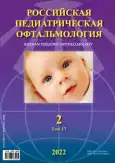Аdaptation and quality of vision in glasses with lenses for the control of stellest myopia with built-in high-spherical microlenses
- Authors: Proskurina O.V.1, Tarasova N.A.1, Markosyan G.A.1, Arutyunyan S.G.1, Milash S.V.1, Tarutta E.P.1
-
Affiliations:
- Helmholtz National Medical Research Center of Eye Diseases
- Issue: Vol 17, No 2 (2022)
- Pages: 5-12
- Section: Original study article
- URL: https://journals.rcsi.science/1993-1859/article/view/97296
- DOI: https://doi.org/10.17816/rpoj97296
- ID: 97296
Cite item
Abstract
AIM: Evaluate the visual adaptation and vision quality of glasses with Stellest lenses.
MATERIAL AND METHODS: A total of 35 children aged 8–13 years (average: 10.5±0.27 years) with mild and moderate myopia (average: 3.15±0.19 dpt) in glasses with Stellest lenses and 30 children aged 8–13 years (average: 10.4±0.3 years) with mild and moderate myopia (average: 2.66±0.2 dpt) in monofocal glasses as the control group. Refraction and visual acuity (OS) were assessed after the appointment of glasses. Ergonomic tests were conducted 3–4 months after the children started wearing them. At 3–4 weeks after they started wearing glasses, all patients filled out a questionnaire of 8 questions.
RESULTS: The monocular distance in the Stellest glasses averaged 1.17±0.02, and the specific values were 1.24±0.03 for binoculars, 1.09±0.02 for monofocal glasses, and 1.160.02 for binocular glasses. Near monocular OZ in Stellest glasses averaged 0.95±0.01 and 0.96±0.01 for binocular glasses; the values were 0.96±0.01 and 0.97±0.01 for monofocal glasses. The minimum mesopic contrast sensitivity in Stellest glasses was 3.76±0.04 (with a reference value of 4) and 3.44±0.1 in the trial frame (p <0.05). In the conditions of the glare effect, the values of 7.47±0.08 for the Stellest glasses (with a reference value of 8) and 6.76±0.2 for monofocal glasses were observed (p <0.01). In monofocal glasses, the corresponding indicators were 3.71±0.09 and 7.2±0.14. Under the conditions of the gler effect, the indicator was 0.84 higher than that of the trial frame (p <0.01). The tendency to lower ergonomic indicators in Stellest glasses has been revealed. The subjective assessment of the quality of vision was high in both groups
CONCLUSION: A preliminary assessment revealed highly functional and ergonomic performance and good portability of glasses with Stellest lenses.
Full Text
##article.viewOnOriginalSite##About the authors
Olga V. Proskurina
Helmholtz National Medical Research Center of Eye Diseases
Author for correspondence.
Email: proskourina@mail.ru
ORCID iD: 0000-0002-2496-2533
MD, Dr. Sci. (Med.)
Russian Federation, MoscowNatalia A. Tarasova
Helmholtz National Medical Research Center of Eye Diseases
Email: tar221@yandex.ru
ORCID iD: 0000-0002-3164-4306
SPIN-code: 3056-4316
MD, PhD
Russian Federation, MoscowGajane A. Markosyan
Helmholtz National Medical Research Center of Eye Diseases
Email: dvdomdv@mail.ru
ORCID iD: 0000-0002-2841-6396
MD, Dr. Sci. (Med.)
Russian Federation, MoscowSona G. Arutyunyan
Helmholtz National Medical Research Center of Eye Diseases
Email: arutyunyansg@mail.ru
ORCID iD: 0000-0002-3788-2073
MD, PhD
Russian Federation, MoscowSergey V. Milash
Helmholtz National Medical Research Center of Eye Diseases
Email: sergey_milash@yahoo.com
ORCID iD: 0000-0002-3553-9896
SPIN-code: 5224-4319
MD, PhD
Russian Federation, MoscowElena P. Tarutta
Helmholtz National Medical Research Center of Eye Diseases
Email: elenatarutta@mail.ru
ORCID iD: 0000-0002-8864-4518
MD, Dr. Sci. (Med.), professor
Russian Federation, MoscowReferences
- Schaeffel F, Feldkaemper M. Animal models in myopia research. Clin Exp Optom. 2015;98(6):507–517. doi: 10.1111/cxo.12312
- Troilo D, Smith EL, 3rd, Nickla DL, et al. IMI - Report on Experimental Models of Emmetropization and Myopia. Invest Ophthalmol Vis Sci. 2019;60(3):M31-M88. doi: 10.1167/iovs.18-25967
- Tarutta EP, Proskurina OV, Markossian GA, et al. A strategically oriented conception of optical prevention of myopia onset and progression. Russian Ophthalmological Journal. 2020;13(4):7–16. (In Russ). doi: 10.21516/2072-0076-2020-13-4-7-16
- Tarutta EP, Proskurina OV, Milash SV, et al. Peripheral defocus induced by «Perifocal-M» spectacles and myopia progression in children. Russian pediatric ophthalmology. 2015;10(2):33–37. (In Russ). doi: 10.17816/rpoj37658
- Tarutta EP, Proskurina OV, Tarasova NA, et al. Long-term results of perifocal defocus spectacle lens correction in children with progressive myopia. Vestnik oftal’mologii. 2019;135(5):46. (In Russ). doi: 10.17116/oftalma201913505146
- Lam CSY, Tang WC, Tse DY, et al. Defocus Incorporated Multiple Segments (DIMS) spectacle lenses slow myopia progression: a 2-year randomised clinical trial. Br J Ophthalmol. 2020;104(3):363–368. doi: 10.1136/bjophthalmol-2018-313739
- Lam CS, Tang WC, Lee PH, et al. Myopia control effect of defocus incorporated multiple segments (DIMS) spectacle lens in Chinese children: results of a 3-year follow-up study. Br J Ophthalmol. 2021. doi: 10.1136/bjophthalmol-2020-317664
- Bao J, Huang Y, Li X et al. Spectacle lenses with aspherical lenslets for myopia control vs single-vision spectacle lenses. A randomized clinical trial. JAMA Ophthalmol. 2022. doi: 10.1001/jamaophthalmol.2022.0401
Supplementary files







